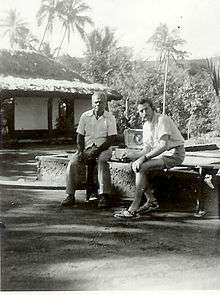George W. Grace

George William Grace (8 September 1921 in Corinth, Mississippi – January 17, 2015)[1] was an emeritus professor of linguistics at the University of Hawaiʻi. He specialized in historical and comparative linguistics, ethnolinguistics, and Austronesian languages, especially the Oceanic languages of Melanesia. He joined the Department of Linguistics in 1964, serving three years as chair (1966–1969) and three decades as editor of Oceanic Linguistics (1962–1991), a journal he founded while teaching anthropology at Southern Illinois University (1960–1964).
Biography
Grace was raised on the Gulf Coast. After service with the United States Army Air Corps (1942–1946), he remained in Europe to earn his first university degree, a licence in political science from the Graduate Institute of International Studies in Geneva in 1948. He then accepted a position as a junior research anthropologist at the University of California, Berkeley, where he did fieldwork in 1951 on the Luiseño language, collaborating with Alfred L. Kroeber on The Sparkman Grammar of Luiseño (University of California Press, 1960). In 1953–1955 he was a research associate for the Tri-Institutional Pacific Program (a consortium of Yale University, the University of Hawaii, and the Bernice P. Bishop Museum in Honolulu) and then for Yale University conducting research in Austronesian linguistics. In 1955–1956 he conducted a survey in the field of many languages in the Solomon Islands, New Caledonia, Papua New Guinea, and the former Netherlands New Guinea. In 1956–1957 he was an associate in Malayo-Polynesian linguistics at the Bishop Museum.
He completed a Ph.D. dissertation in 1958 under Joseph Greenberg at Columbia University, which was published the following year under the title The Position of the Polynesian Languages within the Austronesian (Malayo-Polynesian) Language Family. After teaching at the Woman's College of the University of North Carolina (now, University of North Carolina at Greensboro) (1958–1959), at Northwestern University (1959–1960), and at Southern Illinois University (1960–1963), and serving as scholar in residence at the East-West Center in Honolulu (1964), he was hired by the newly formed Department of Linguistics at the University of Hawaiʻi, where he has remained, apart from further fieldwork in New Caledonia (1970, 1971–1973) and New Guinea (1976).
The problem of translation
The postulate that it is possible to translate anything (no matter what) into any language (no matter which), he distinguished two idealized interpretations of the postulate. These were called the locutionary and perlocutionary interpretations. In the locutionary interpretation the claim is that, given any linguistic expression in any language, it is possible to find in any other language a linguistic expression with the same content. In the perlocutionary interpretation the claim is that anything (i.e., anything sayable) can be made understandable to anyone by means of that person's own language.
In the locutionary interpretation, then, what we might regard as "the translation" takes the form of a linguistic expression. Note that in this interpretation no claim is made about the understandability of the translation—i.e., about who might be expected to be able to understand it. In the perlocutionary interpretation, on the other hand, "the translation" should probably be thought of, not as a linguistic expression, but rather as the act of explaining—that is, as a performance, mainly verbal, by the translator. Although the performance of the translator (or better, "explainer"?) would involve the uttering of linguistic expressions, and although these linguistic expressions could be recorded, they are likely to lack cohesion. They are likely to include questions, answers to questions, trials and errors, false starts and restatements, etc., and they might have been accompanied by extensive non-verbal clues. It would hardly seem appropriate to think of such recorded explanations as themselves constituting the translation.
Mapping view
The basic epistemological assumption of the mapping view might be stated as follows: there is a common world out there and our languages are analogous to maps of this world .. Thus, this common world is represented or 'mapped' (with greater or less distortion) by all languages.world up' - in the way they ' classify' its phenomena.[2] The linguistic construction of reality. This model does not corresponds to the reality 1:1,there are distortions and disturbances.Each language has a slightly different mapping which could be explained by the fact,that different people have different understanding, for example having temporal phenomena,see Gumperz / Levinson (eds.) 1997:55 ff .39
Reality Construction view
In the reality-construction view, the imperfectness of our access to knowledge of the real world assumes central importance. Emphasis is placed upon the fact that we do not have direct access to the real world itself, but only to the data about it provided by our senses. And these senses provide very incomplete information. Our eyes, for example, respond only to a very narrow band of wavelengths within the electromagnetic spectrum, our ears only to a certain limited range of vibratory frequencies in the air or some other medium, etc. according to the reality-construction view, what we a recalling the intertranslatability postulate is false. see Grace, G.W. 1987. The linguistic construction of reality The reality constructing hypothesis underlines the lack of perfectness of the linguistic construction which is justified by lack of precision provided by our senses.
References
- Blust, Robert (1991), "George W. Grace: An appreciation" in Currents in Pacific Linguistics: Papers on Austronesian languages and ethnolinguistics in honour of George W. Grace, ed. by Robert Blust, pp. 1–4 (Canberra: Pacific Linguistics). ISBN 0-85883-404-9.
- Grace, George W. (1987), "The linguistic construction of reality", pp. 3–16,55-75. ISBN 0-7099-3886-1.